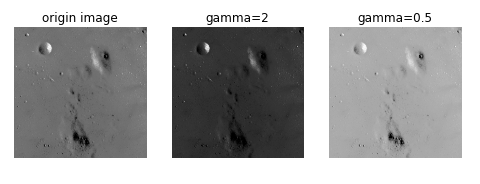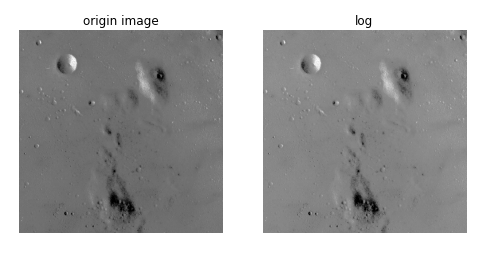图像亮度与对比度的调整,是放在skimage包的exposure模块里面
1、gamma调整
原理:I=Ig
对原图像的像素,进行幂运算,得到新的像素值。公式中的g就是gamma值。
如果gamma>1, 新图像比原图像暗
如果gamma<1,新图像比原图像亮
函数格式为:skimage.exposure.adjust_gamma(image, gamma=1)
gamma参数默认为1,原像不发生变化 。
from skimage import data, exposure, img_as_float import matplotlib.pyplot as plt image = img_as_float(data.moon()) gam1= exposure.adjust_gamma(image, 2) #调暗 gam2= exposure.adjust_gamma(image, 0.5) #调亮 plt.figure('adjust_gamma',figsize=(8,8)) plt.subplot(131) plt.title('origin image') plt.imshow(image,plt.cm.gray) plt.axis('off') plt.subplot(132) plt.title('gamma=2') plt.imshow(gam1,plt.cm.gray) plt.axis('off') plt.subplot(133) plt.title('gamma=0.5') plt.imshow(gam2,plt.cm.gray) plt.axis('off') plt.show()

2、log对数调整
这个刚好和gamma相反
原理:I=log(I)
from skimage import data, exposure, img_as_float import matplotlib.pyplot as plt image = img_as_float(data.moon()) gam1= exposure.adjust_log(image) #对数调整 plt.figure('adjust_gamma',figsize=(8,8)) plt.subplot(121) plt.title('origin image') plt.imshow(image,plt.cm.gray) plt.axis('off') plt.subplot(122) plt.title('log') plt.imshow(gam1,plt.cm.gray) plt.axis('off') plt.show()

3、判断图像对比度是否偏低
函数:is_low_contrast(img)
返回一个bool型值
from skimage import data, exposure image =data.moon() result=exposure.is_low_contrast(image) print(result)
输出为False
4、调整强度
函数:skimage.exposure.rescale_intensity(image, in_range='image', out_range='dtype')
in_range 表示输入图片的强度范围,默认为'image', 表示用图像的最大/最小像素值作为范围
out_range 表示输出图片的强度范围,默认为'dype', 表示用图像的类型的最大/最小值作为范围
默认情况下,输入图片的[min,max]范围被拉伸到[dtype.min, dtype.max],如果dtype=uint8, 那么dtype.min=0, dtype.max=255
import numpy as np from skimage import exposure image = np.array([51, 102, 153], dtype=np.uint8) mat=exposure.rescale_intensity(image) print(mat)
输出为[ 0 127 255]
即像素最小值由51变为0,最大值由153变为255,整体进行了拉伸,但是数据类型没有变,还是uint8
前面我们讲过,可以通过img_as_float()函数将unit8类型转换为float型,实际上还有更简单的方法,就是乘以1.0
import numpy as np image = np.array([51, 102, 153], dtype=np.uint8) print(image*1.0)
即由[51,102,153]变成了[ 51. 102. 153.]
而float类型的范围是[0,1],因此对float进行rescale_intensity 调整后,范围变为[0,1],而不是[0,255]
import numpy as np from skimage import exposure image = np.array([51, 102, 153], dtype=np.uint8) tmp=image*1.0 mat=exposure.rescale_intensity(tmp) print(mat)
结果为[ 0. 0.5 1. ]
如果原始像素值不想被拉伸,只是等比例缩小,就使用in_range参数,如:
import numpy as np from skimage import exposure image = np.array([51, 102, 153], dtype=np.uint8) tmp=image*1.0 mat=exposure.rescale_intensity(tmp,in_range=(0,255)) print(mat)
输出为:[ 0.2 0.4 0.6],即原像素值除以255
如果参数in_range的[main,max]范围要比原始像素值的范围[min,max] 大或者小,那就进行裁剪,如:
mat=exposure.rescale_intensity(tmp,in_range=(0,102)) print(mat)
输出[ 0.5 1. 1. ],即原像素值除以102,超出1的变为1
如果一个数组里面有负数,现在想调整到正数,就使用out_range参数。如:
import numpy as np from skimage import exposure image = np.array([-10, 0, 10], dtype=np.int8) mat=exposure.rescale_intensity(image, out_range=(0, 127)) print(mat)
输出[ 0 63 127]






















 894
894











 被折叠的 条评论
为什么被折叠?
被折叠的 条评论
为什么被折叠?








